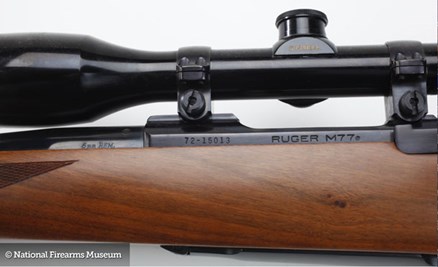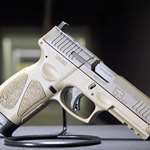
The 1960s was a tumultuous decade—the Cuban Missile Crisis, Bay of Pigs invasion, Kennedy assassination, the Vietnam War, hippie movement, Woodstock, race riots and the British Invasion of rock and roll, all of which continue to impact our society and culture more than a half century later. Another change—somewhat less profound to society in general but monumental to gunners—was the dismissal of the venerated Mauser-style claw extractor on the bolt-action rifle.
Paul Mauser’s claw extractor was a defining characteristic of his Model 1898 rifle. It is a piece of spring steel about 4 3/4" long and .40" wide that rides side-saddle and parallel to the bolt. Up front on the bolt face the extractor has a hook-like extension that sits forward of the bolt face just enough to allow a cartridge case rim to slide between it and the bolt face as the bolt is pushed forward picking up a fresh cartridge from the magazine. The alleged advantage is that the cartridge case is always under full control of the shooter, thereby eliminating any chance of a double feed jamming the rifle, hence the moniker of “controlled-round-fed” rifle. Well alleged doesn’t mean always. It is possible to double feed a controlled-round-fed rifle. I’ve done it. Don’t ask how.
Remington had long since shunned the Mauser claw in favor of an “improved Mauser” design that featured a pressed spring steel extractor shaped like a “C” that snapped into a recess on the bolt face. And instead of milling a slot in the bolt face and mating it with a blade of steel to serve as an ejector, Remington engineers developed a spring-loaded plunger into the bolt face that sent cases out of the receiver with great vigor, regardless of how gently one operated the bolt. This came about with the early-post-war Model 721 and was carried over in the Model 700 introduced in 1963. This improved-Mauser design is much less expensive to manufacture, and the ’60s were all about cutting manufacturing costs.
Winchester finally relented and adopted the improved Mauser design in 1964 to its famous Model 70—The Rifleman’s Rifle. Mossback gunwriters like Elmer Keith and Jack O’Connor howled like freshly branded calves over the change. Both of them were longtime handloaders and did not care for ejecting cases “over second base,” as O’Connor once put it, with empty shell cases getting tossed off of their shooting benches and onto the ground.
Enter one William Batterman Ruger—Bill Ruger—who was muscling his way into the top tier of American gunmakers. Ruger had been earning his bones with his Standard Auto Pistol which had taken the plinking pistol market by storm since 1949. Six years later he spanked Colt a good one when he brought forth the Blackhawk series of single-action revolvers—strong revolvers with internal improvements from the original design and more reliable than the venerable Colt SAA.
Ruger could not defy the logistics of cost directly. Forgings cost real money to produce. But he could and did refine how to produce strong parts of guns by employing the then-new technology of investment casting. Springs—and extractors—may not be able to be cast, but receivers, bolts, bolt handles and trigger guards could be, thus saving a fair amount of production money. Ruger tapped a one-time Eugene Stoner designer, L. James (Jim) Sullivan to help him build a rifle worthy of a Keith-O’Connor blessing.
Though Ruger was a modern engineer of the first order, in terms of design and aesthetics he was a true Renaissance man—a devotee and appreciator of old-school construction. He recruited legendary classic stockmaker Lenard Brownell to design the stock of his first bolt-action rifle. The result of the Ruger-Sullivan-Brownell effort was the Model 77 rifle introduced in 1968.
The Model 77 wasn’t just a rehash of a then-69-year-old rifle. Just as he did with his other gun designs, Ruger employed coil springs wherever he could. The old bolt-mounted wing safety gave way to a two-position, tang-mounted button, far less obtrusive and yet a more natural—or intuitive, to use our modern day parlance—device to operate, equally available to right handers, as well as lefties. He also redesigned the fire-control system to provide a crisp, relatively light, yet safe trigger. The most talked about innovation, though, was the angled forward guard screw.
Traditional Mauser-based designs utilize a vertical screw in a hole of the flat of the receiver behind the recoil lug. To keep the stock from splitting, the inletting in this area must be very precise. There must be intimate contact between steel and wood. Today we use epoxy compounds or a machined chassis to accomplish this, and most stocks are no longer made from wood. But Ruger was a traditionalist in terms of aesthetics, so straight-grained walnut was the material of choice for his stocks in 1968. To get that intimate contact without having an assembler spend an hour to inlet each stock, Ruger rough inleted the stock quite close and then utilized an angled screw to draw the wood and steel together. The result was a well-bedded stock with a nice, close fit that was less expensive to produce.
One of the uncanny characteristics of Ruger was—and remains today nearly 15 years after his passing—is the ability to hit a niche-market nail square on the head. The Model 77 gave the shooting consumer exactly what he or she seeks—an accurate, reliable rifle that looks good and doesn’t cost an arm and a leg.
While the first iteration of the Model 77 was pretty successful, the old shoolers still groused about a few things. First, it wasn’t a true controlled-round-feed. The side-saddle claw extractor was there alright, but it snapped over the cartridge rim after the bolt bumped the cartridge from the magazine loosely into the chamber area—hence the not-so-complimentary nickname, bump-and-run bolt action. Sullivan, when he designed the bolt to be made from an investment casting, retained the new plunger-style ejector which gave handloaders fits. Initially there were concerns over the strength of investment-cast receivers and bolts, but those were abated once independent tests revealed that the new alloys and heat treating made the investment-cast parts actually stronger than the older forgings.
By the time 1989 rolled around Ruger had seen the light regarding controlled-round feeding, plunger-style ejectors and rather clubby stocks. The Model 77 Mark II debuted as a true controlled-round-feed, with a blade ejector, a three-position safety mounted on the rear of the bolt and a somewhat slimmer stock. The Model 77 enjoyed some resurgence in popularity, spurred partly due to the Mark II changes but also because of variants like Varmint, Lightweight and International versions, the last featuring a full-length Mannlicher-style stock.
In 2006 Ruger gave its masthead rifle another facelift in the form of the Ruger Hawkeye. The stock was once again recontoured to a more easily handled profile and the new LC 6 trigger addressed some of the issues voiced with the previous trigger. Overall accuracy issues were also dealt with, making the Hawkeye one of the most accurate out-of-the-box factory rifles ever built.
Today there is almost no mention of the Model 77 rifle, except in rimfire configurations. The Hawkeye, Guide Gun and African all occupy the space once allocated for the Model 77. Their heritage and characteristics are pure Model 77, though. Ruger’s dream of producing accurate, reliable and good looking rifles that are available to any American working man remains solvent. Whether you call it the Model 77, Mark II, Hawkeye or any other name, this rifle ain’t going anywhere for a long time. It has an excellent foothold with American hunters and shooters.





































